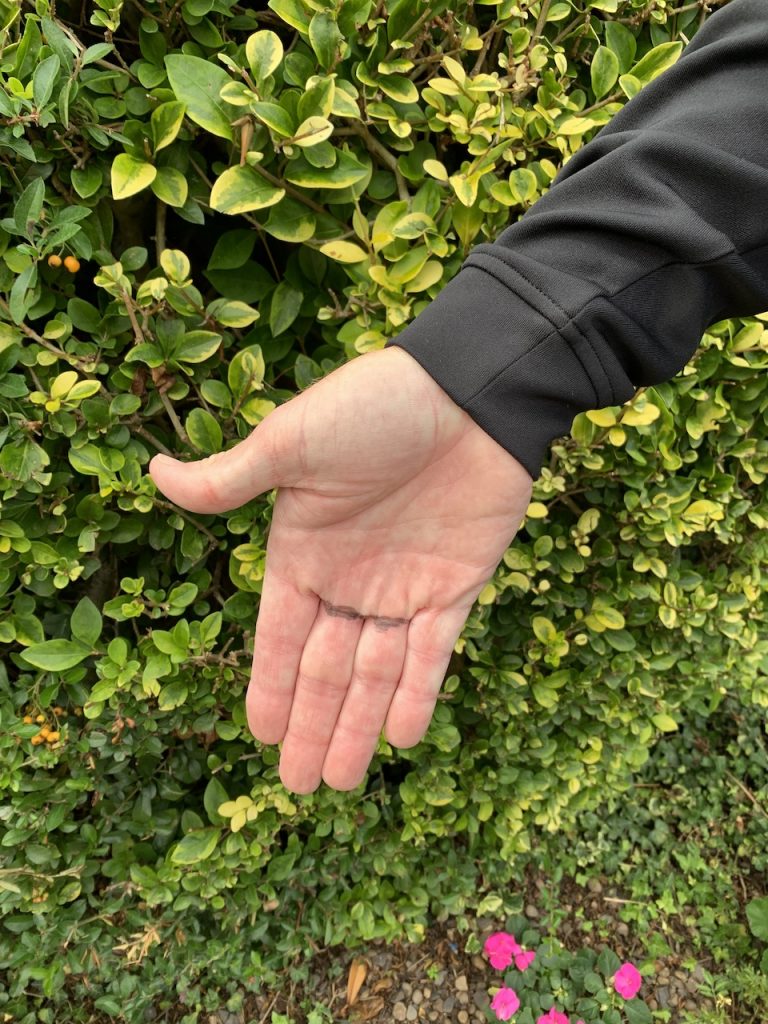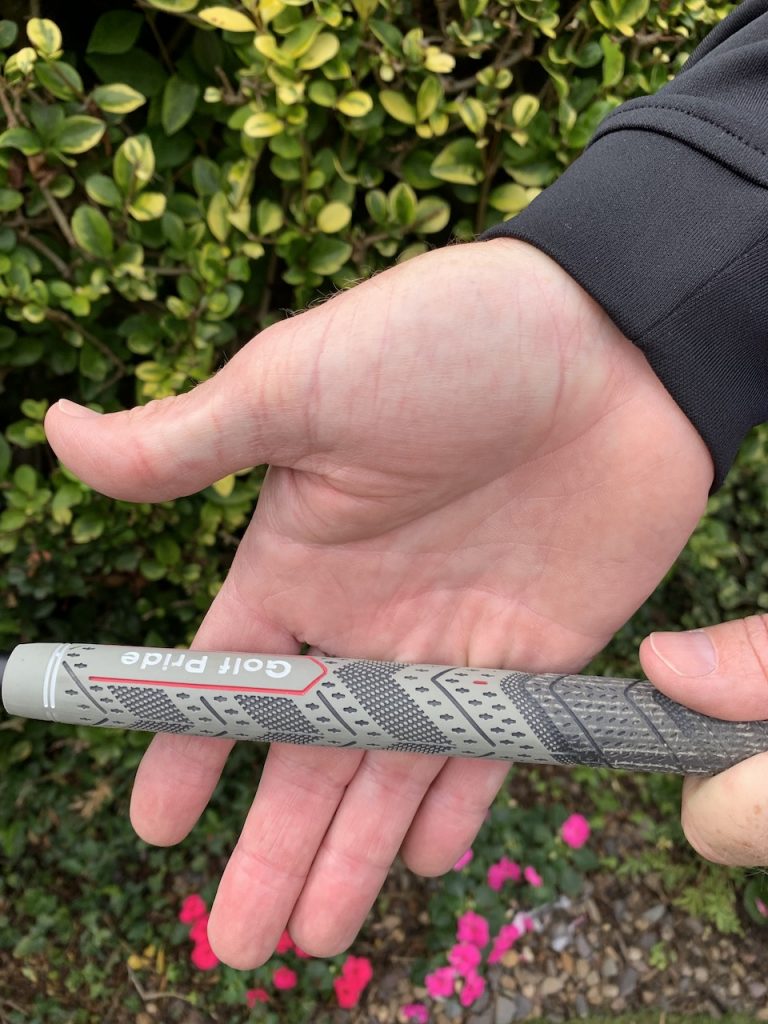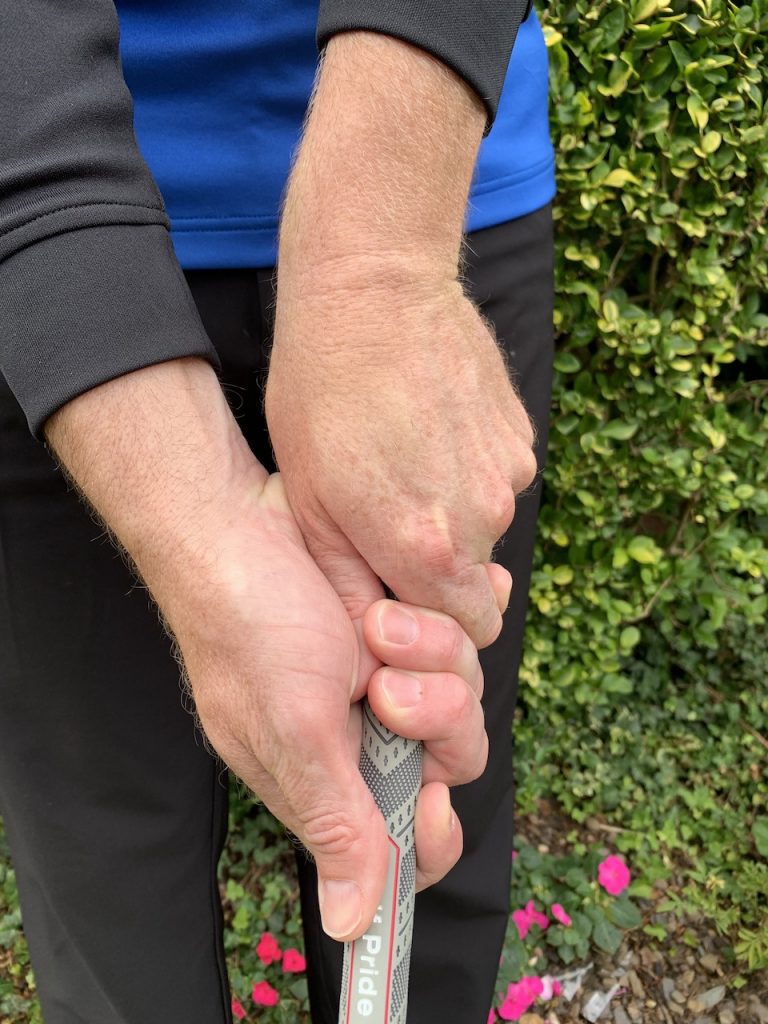What’s the purpose of the proper golf grip? What will I gain from getting my golf grip right?
The sole purpose of a proper golf grip is to control the clubface. It’s your only link to the club, get this right, and it can transform your golf game, but get it wrong, and it will hold you back for sure.
The three standard golf grips are the Overlapping Grip (Vardon), the 10 Finger Grip, and the Interlocking Grip. They are all correct ways of holding the club, and it’s simply a matter of finding the one that suits you best. I recommend that you try every golf grip.
However, there are two other types of golf grips, which are the BUTTERFLY golf grip, and if you play right-handed, you could put your left hand below your right, which is classed as unconventional and is not a recommended, but I know a few golfers who benefit from gripping this way.
The Left Hand
Let’s get into more detail about how to place the club into your hands correctly. (For this blog, I will be referring to a right-handed golfer). Starting with your left hand first, there are two guidelines on your hand that will help you position the club correctly. The middle crease on your index finger and the crease just above your little finger are highlighted here.

Once you have placed the golf club in your hand correctly, there are a few things to check as you close your fingers and thumb around the club, which are your thumb sits either on top of the golf grip or slightly to the right side of the golf grip and you should be able to see at least two knuckles of your left hand.

You should then place your golf club diagonally across these two points.

Your fingers wrap around the club to secure it in place, as seen here.

The two lines at the top of the golf grip guide your hand to sit just below them and not cover them. Regarding how tight you should be holding the club on a scale of 1 to 10, if ten is the tightest you can hold the club, it should be a maximum of 5. In my case, I hold it at 3.
If you are holding the club in the right place in your left hand, there is a simple way of checking it. If you take your back three fingers and thumb off the golf grip, the club should rest under the meaty pad of your hand and the crease in your index finger and should be perfectly balanced. If the club goes up the palm of your hand, you will find that the club slips, and you will struggle to keep hold of it.

Once you are happy with this, then replace your fingers and thumb onto the club.
A crease is formed between your thumb and index finger, which should point between your chin and left shoulder.
The Right Hand
Now it’s time to put your right hand onto the club. I will demonstrate the overlapping grip first and explain the other golf grips afterward.
The crease formed where the two middle fingers join your hand is the guideline we will be using.

Place the club along these two lines.
Now to make the golf club secure, I would like you to wrap your fingers around and close your hand onto the golf grip, slightly separate your right index finger and allow the club to rest in the middle joint of your index finger, as shown here.

This is known as the trigger finger and would be similar to pulling the trigger on a gun. Once you are happy with the index finger placement, you need to rest your right thumb onto the golf grip. Placing it onto the left side of the golf grip will form a “V” shape between your right index finger and thumb.

Overlap Grip
Now we need to link the hand together, and we can do this in one of three ways. Let’s start with the overlap golf grip first. I would like you to take the little finger of your right hand off the golf grip

so that we can place it in the gap between your left index finger and middle finger of your hand. By sliding both hands together, we can now complete the overlap golf grip. By holding the golf club this way is to unite the hands to complement each other and work as a unit. Now, this doesn’t feel comfortable for some golfers with different-sized hands and fingers, and that is why I’ll show you two other ways of holding the club to find out which is best for you.
Interlocking Grip
Again, let’s start with your left hand first. In the same way, you should place your left hand on the golf club, as mentioned at the start of this blog. Keeping your index finger off the golf grip so that we can connect the hands in a slightly different way, again placing your right hand onto the club in the same way as described above, I would like you to hold your right little finger off the golf grip and slide your hands together so that your left index finger and your right little finger are off the golf grip.

Now, instead of resting your right little finger in the gap, we will interlock your index and little finger together.
Holding the golf club in this way can feel secure for some golfers and helps them unite their hands securely. Again, depending on the size of your hands and fingers, this may or may not feel very comfortable, but it’s well worth trying.
The Ten Finger Grip
The ten-finger proper golf grip is quite popular for golfers with smaller hands or ones who have large fingers. It’s the least popular of the three proper golf grips but, nevertheless, a correct way to hold the golf club.
So let’s start with the left hand again first. In the same way, described at the start of this blog, place the golf club in your hand with all fingers and thumbs on the club.
And again, in the same way, as described above, place your right hand onto the golf club but this time wrap your little finger onto the club as well.
Now we are going to slide your right hand up the grip until both hands touch each other, but we are not going to unite them in any way, and this will form a ten-finger grip as all ten fingers will be on the grip.

This way of holding the golf club can feel very strong for most golfers and is well worth trying, but remember to keep your grip pressure under five to avoid adding extra tension to your body.
I would recommend hitting at least 20 golf balls with each grip to give them a fair trial. It’s normal for one to feel much nicer than the others, and I would recommend that you stick to this way of holding the golf club. The nice thing is you can now use the same grip for all the golf clubs in your bag, except for the putter.
As I mentioned at the start, two other ways of holding the golf club are to have the left hand below the right hand and the butterfly grip. I would call specialist grips and the least used, but I must explain both of them.
Right Hand Above Left Hand
In the same way, as I said about placing the left hand onto the grip, you do the same thing with your right hand. The golf club runs through the middle crease of your index finger to the crease just above your little finger. It wraps your hand around the golf club, keeping your right thumb either on top or just the left-hand side of the grip.
Placing the left hand onto the golf club should be done in the same way as mentioned earlier.
We can unite them in the same way via the interlock, overlap, or ten-finger method. As seen here.
The reason some golfers hold the golf club in this could be that they are naturally left-handed but like to play right-handed, and this way of holding the golf club feels more natural to them, or they may have an issue with one or both arms and holding the golf club this way enables them to still play golf. I have no issues with that either. Playing golf this way can limit the amount of hand and arm movement throughout the entire swing, but as I often say to my students, there is always more than one way to play golf, and if this way of holding the golf club works for you, then stick with it.
The Butterfly Grip
The Butterfly grip is one of the least known grips. I would describe it as a specialist golf grip most commonly only used for chipping and bunker shots. It’s a way of holding the golf club that neutralizes both hands and lets you keep more loft on the clubface through impact without pointing the golf club to the right. It’s fantastic for putting more spin on the golf ball, which gives greater control when the ball lands on the green.
So let’s start with your left hand first in the same way I spoke about the golf club’s earlier place through the middle joint of your left index finger and the crease above your little finger. Still, this time, when you wrap your hand over the golf club, make sure that you can see all the knuckles of your hand, and your thumb will move around to the right-hand side of the golf grip, this is what is commonly known as a strong grip which you’ll see here.

This will feel very strange for some golfers, and you should get the feeling that your left forearm feels straighter and more around to the right.
And again, as I mentioned earlier, we should place your right hand on to the golf club in the same way, but this time, I would like you to turn the hand over to the left side of the golf grip so that you can see all the knuckles of your right hand and your thumb will be over to the left side of the grip.

This would be described as a weak right-hand grip. So we have a strong left hand and a weak right-hand grip. Now, if you open all of my fingers, it should resemble a butterfly.
By placing your right hand on the golf club this way, your right arm will appear straighter and more around to the left than normal. Regarding connecting your hand, you can still do an interlocking grip, overlapping grip, or ten fingers grip.

As I said, this is a specialist golf grip and requires a lot of practice to feel comfortable, but the control you can get over the clubface is incredible and well worth persevering with if you want to add more spin to the ball.
Strong Grip
What is a strong golf grip?
As some golfers believe, a strong proper golf grip is not how tight you are holding the golf club, but simply both of your hands are too far around to the right (If you are right-handed).
As you will see, four knuckles are showing on the left hand, and the right thumb is resting on the right side of the golf grip rather than being on the left side of the grip. This proper golf grip does feel very natural for those golfers who hold the golf club in this way, but subconsciously they will be manipulating the clubface through impact to avoid shots that commonly go too far left. The golf shots that golfers with strong grips commonly struggle with are hitting a high shot, bunker shots, lob shots, and fades. These can be played if the golfers spend a lot of time practicing, but the average golfer will struggle to play such shots. The normal shots with a strong grip are draw or hook shots, quite a long hitter, lower ball flight, and running shots due to the clubface rolling through impact.

Weak Grip
What is a weak golf grip?
In short, it’s the complete opposite of a strong golf grip. If you are a right-handed golfer starting with your left hand first when your hand is placed on the golf club, you will struggle to see any knuckles on your hand, and commonly your thumb will be to the left side of the golf grip.
What also often happens is the golf club sits in the palm of the left hand rather than across the middle joint of your index finger and the crease above your little finger.
When the right hand is placed on the club, most if not all of the knuckles will be visible, meaning that the right hand is wrapped too far over to the left side of the grip.
The shots that golfers hit with a weak golf grip are high, right, left to right, short distance, struggle into the wind, and shanking the golf ball, but they are often very good at lob shots, bunker shots, chipping, and high shots on demand. These are made easier as it’s natural the open the clubface and add extra loft through impact using this grip.

Proper Golf Grip Pressure
No matter which grip you play with, it’s really important that you hold the golf club with the right amount of grip pressure. On a scale of 1 – 10, if ten is the tightest you can hold the club, you shouldn’t hold it at more than 5. A simple way to judge this is to hold the club as tight as possible and hold it for 2 seconds and then relax; you should feel the tension drop out of your body and feel a more relaxed grip. This amount of tension is often the best. Most commonly, golfers hold the golf club way too tight, and strangely, the golf club’s issue is that it slows down your hand speed and will cause a loss of distance. There is a lovely quote that I often pass on to golfers ( TENSION steals your FEEL and ROBS you of your TALENT ). I would advise you to hit golf balls with varying amounts of grip tension to discover which is best for you and stick with it.
Size
So we have covered the various types of holds, but we should also consider the different thicknesses of grips available. Let’s start with the size of your hands. Generally, if you are male and have a medium size, a standard thickness of grip will be wet-suited to you. Still, if you have a medium size palm but have short fingers, then a smaller size grip might suit you best, or if you have a medium palm and longer fingers, then a midsize or even jumbo grip could be the best option.
The different sizes of grips available are as follows.
No matter what grip size you opt for, I would always recommend trying different thicknesses and finding out which suits you best. Something to be aware of is if your grip is too thick, then this can reduce your hand action through impact and can cause you to leave the clubface open, and if the grip is too thin, then this can encourage your hand to be too active through impact and close the clubface very easily.
Tape
Many golfers don’t realize that extra tape can be added underneath the grip to thicken the grip. For instance, if you feel that a standard grip thickness is not thick enough, a midsize grip is too thick. An extra two layers of tape will make quite a difference, sometimes it’s a bit of trial and error, and if you chat to a good custom fit person, they will be able to advise.
Condition of a Grip
Many golfers often overlook Grip condition and do not consider it a real issue, but I can tell you that it’s a massive consideration. The acid test is to hold the golf club up to the light, and if it appears shiny, it either needs cleaning or replacing. The issue with a shiny grip is that you will instinctively hold the golf club tighter to keep hold of it, which will shorten your muscles and reduce clubhead speed. Let’s say that you feel the grip needs a good clean, and then this is how to do it.
You will need the following:
- Soap
- Hot water
- Metal scouring pad
- Towel
Start by running your grip under hot water, then apply the soap. Using the scouring pad gives the grip a good rub all over to clean off the dirt and oil that your hands have put on it. This may take a couple of attempts, run the grip under hot water again to take off the excess soap and dirt, and then towel dry the grip. If your grip looks dull, it is probably nice and clean, but if it is still shiny, either re-wash it or replace it. On average, you should be replacing your grips at least once every two years, but if you play regular golf, then you should consider replacing them every year.
Golf Glove
A question I am often asked is should you wear a golf glove? My answer is always personal preference. I choose not to wear a glove unless my hands get hot, in which case I find them beneficial. Remember, golf gloves provide additional grip, so you must wear a glove that fits the purpose. The amount of golfers I see with holes in their gloves and shiny black marks on them is astounding. Again, the issue is that you will have to hold the club tightly again to keep hold of the club, and you’ll get the same effect as having a shiny grip. Golf gloves are relatively inexpensive, and I would always recommend that you have at least two fit-for-purpose gloves in your bag and throw away overly used gloves. The acid test is if you think it might be unfit for purpose, then it will be, so chuck it away.
Now, check your grip and equipment.
Final Thoughts
I hope you have enjoyed learning about the different ways you can hold a golf club to have a proper golf grip. Taking time to get your grip right is time well spent. I have had the privilege of coaching thousands of golfers, and generally, the most successful golfers spend time on the fundamentals, including the grip, setup, and body alignment. If you do need to change your grip, give it time to feel normal, and don’t be tempted to go back to what feels comfortable, as this will stop you from progressing towards a perfect golf grip.

